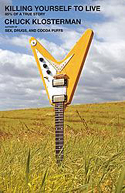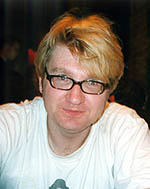Death, Rock'n'Roll, and a Side of Gravy
|
|
Chuck Klosterman's latest project is a pop culture road trip, Killing Yourself to Live: 85% of a True Story (coming from Scribner in July), in which he drove across the U.S. searching out the graves and death sites of rock stars.
Springing fully formed into the pop culture spotlight with his 2001 debut, Fargo Rock City: A Heavy Metal Odyssey in Rural North Dakota (also Scribner), Klosterman tapped into a hitherto unnoticed demographic: literate adults who were once teen metal fans. Fargo Rock City's success propelled Klosterman, previously a writer for the Akron, Ohio, Beacon Journal, onto the national stage. Before long he was writing for the New York Times Magazine, Entertainment Weekly, and GQ. When he was offered a staff writing position at Spin magazine, he jumped at the chance.
 Klosterman grew up expecting to be an English teacher and a coach. "In fact," he said in a recent e-mail interview, "it is still my dream to be an offensive coordinator for an SEC football team." While Klosterman always wrote, he never imagined he could live as a writer. He had pursued journalism in college in the hope that it might prepare him for a job. He was very happily surprised to discover how much he loved it. "I was so fortunate," he explained. "The one skill I could do, just happened to be the only job I completely loved doing."
Klosterman grew up expecting to be an English teacher and a coach. "In fact," he said in a recent e-mail interview, "it is still my dream to be an offensive coordinator for an SEC football team." While Klosterman always wrote, he never imagined he could live as a writer. He had pursued journalism in college in the hope that it might prepare him for a job. He was very happily surprised to discover how much he loved it. "I was so fortunate," he explained. "The one skill I could do, just happened to be the only job I completely loved doing."
Klosterman had been a metalhead teenager with all the selfish and shortsightedness associated with the age. Of all the rock stars who shuffled off this mortal coil during those years, it was the car-crash death of Hanoi Rocks drummer Nicholas "Razzle" Dingley that affected him most. Why? "Because he was killed by [Motley Crue singer] Vince Neil, and I was very afraid that this would cause Motley Crue to break up."
Despite his fears for Neil, in Killing Yourself to Live Klosterman writes, "I don't think I have ever been moved by the death of a public figure." However, this didn't stop him from taking on a 6,000-mile trip around the U.S. to try to figure out why "sometimes rock stars don't start living until they die." The book grows from this beginning into a meditation (slacker-styled though it may be) on the place of death in our culture. "We should be thinking about death more," Klosterman said. "It's not like this is theoretical or something." Death freezes a person in time, and with celebrities, Klosterman believes, death allows "people to inject their own desires and ideas into the dead artist's work." Once that artist's work is complete (barring the hidden master tapes, live CDs, unexpected solo album, and digitally manipulated Christmas duet), his or her career can be considered (and claimed by interested parties) as a whole.
One of the attractions of Killing Yourself to Live (named after an early '70s Black Sabbath song) is Klosterman's willingness to think on the page. He goes off on tangents (often about the women he knows), but always returns to dig again and again at a thought until he has laid it -- and sometimes simultaneously himself -- bare. So even now when he talks about death and rock stars, his thoughts are something of a work in progress: "[Death] also (somehow) validates the performer's aesthetic and immediately changes his (or her) iconography."
In his pursuit of understanding that validation, Klosterman talked to everyone: Waitresses ("The best food in the world is in the South"), people in hotel bars in North Dakota, teenagers partying across the hall from him in a Montana motel. His friends and coworkers make frequent appearances, sometimes in the flesh but at least once, hilariously, he has an imaginary conversation with three ex-girlfriends at once.
Klosterman said he's not sure why he has to write about "all the things that normal people simply experience." But even when he's writing about mundanities, such as when he can't hook his iPod* up to his rental car's stereo, he is still entertaining. And the oddness rarely bothers him. His earlier girlfriends found his writing for Spin -- instead of his expected path of slowly working his way up through regional newspapers -- "pretty weird." But at this point, he said, "Any woman who kisses me once [should] assume she might end up in a book."
"What can I do?" he asked. "I write about the things that I love, and I loved all of those women."
The other thing he loves is music. Killing Yourself to Live is full of trenchant and funny opinions -- such as, "Eric Clapton is (arguably) the most overrated rock musician of all time" -- which are sure to please as many readers as annoy. And it's the music, not the public personas, that takes him to the Macon, Georgia, intersection where (a year apart!) two members of the Allman Brothers band died in motorcycle crashes; to the plane crash site in rural Mississippi where three members of Lynyrd Skynyrd died; to Clear Lake, Iowa, where Buddy Holly, the Big Bopper, and Ritchie Valens died; to Memphis (Elvis, of course, and the more recently lamented Jeff Buckley); and to explore the late Kurt Cobain's Seattle. "Once you're dead," he said, "you suddenly have no control over your persona, so your audience gets to dictate everything you supposedly represent." Which seems especially and sadly true of Cobain.
Death might never have been treated so lightly, yet Klosterman's refreshingly honest and deeply personal account of his time on the road, the events that led up to it, his present and past relationships, and the people he meets, make his sometimes frothy take on pop culture into something greater than the sum of its parts. --Gavin J. Grant
* Since Klosterman couldn't connect his iPod, he brought along some CDs. Six hundred of them. He's got his iPod working now and only adds songs he considers "great." We thought it would be interesting to ask what were his top 10 most played tracks as of April 12:
|
1.
|
Beverly Hills, Weezer |
|
2.
|
It Never Rains in Southern California, Albert Hammond |
|
3.
|
Men Don't Change, Amy Dalley |
|
4.
|
Copacabana, Barry Manilow |
|
5.
|
She's on It, Beastie Boys |
|
6.
|
I'm a Cuckoo, Belle & Sebastian |
|
7.
|
Jesus Christ, Big Star |
|
8.
|
Hot & Nasty, Black Oak Arkansas |
|
9.
|
Hollywood Nights, Bob Seeger |
|
10.
|
Cop Killer, Body Count |


